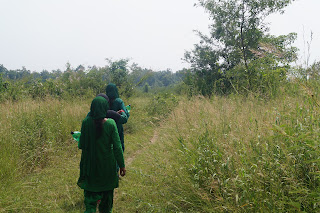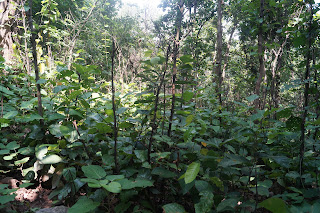THE WOMEN FORESTERS OF AMBOYA
“Yes,
its hard……” asserts Kamla Devi when nudged about the balancing act she performs
everyday along with nine other women of her village. And the balancing act
consists of unending domestic chores on one side and nurturing a patch of dense
sal forest on the other side. “…..but we do it!” The ten women of Amboya
village have been performing a sacred act since more than two decades –
protecting a forest patch that was once degraded due to heavy lopping, illicit
felling and uncontrolled grazing.
 |
| Women marching towards forest for patrolling |
It
all started with silvicultural felling that was carried out in Compartment
number 7 of the Danda - Amboya Reserve Forest over an area of about 36 hectares
in 1984 – 85 after which the forest was left with very few mature sal trees and
some poles. In no time degradation set in as the Forest Department had failed
to protect the area from uncontrolled grazing of domestic cattle, illicit
felling and lopping of trees for firewood and fodder. Under such constrained circumstances for over
a decade, the forest had failed to regenerate, thus threatening its own
existence. However, threat to survival of the forest was perceived as a threat
to their own survival by a few women lead by Maina Devi and Sumitra Devi
prompting a discussion on the matter in the Gram Panchayat meeting. Scarcity of
firewood and fodder had already set in as a fall out of the continued
degradation of the forest patch that shared boundary with Amboya village. Subsequently
Maina Devi and Sumitra Devi succeeded in convincing other women folk of the
village to join hands in protecting the degraded forest. Soon, an army of ten
women stood firm against all odds pledging not only their support but time and
efforts for regenerating the forests. Stiff opposition from rest of the villagers
did not hinder the ten women as they stepped up protection activities in the
year 2000. Compartments 8 and 9 were also brought under protective cover by the
women.
 |
| Young and dense sal trees |
The
first strategy adopted by them was to protect the area from grazing of domestic
animals and keep away those men and women who would destroy the young
regeneration and lop the trees. The task was not easy being an uphill one with
no support from the village. The ladies declared an embargo on grass cutting,
lopping of trees and removal of firewood from the forest. Field officials of
the Forest Department also offered generous support to this endeavor. Armed
with a sickle, a stick and a bottle of water the ten women patrol the area even
today in shifts carving out time from their daily chores looking after the
family, home, agriculture and cattle. Its only their zeal that has increased
over a period of two decades. The extremely hot and dry summer spells are
misused by miscreants to set forest fire in an attempt to destroy fruits of the
decades old protection. Night or day, the ten women are ever alert and prepared
to meet any such devastating forest fires by not only informing the forest
officials but also actively dousing the raging forest fires. Several hundreds
of sickles and axes have been ‘seized’ by these women from people who enter
‘their’ forest. Its not an easy task protecting the forests from hundreds of
cattle and twice the number of human beings surrounding the forest. They deliberate
upon their achievements, activities and efforts required for protection of the
forest in frequent meetings that they hold at least once in a month. The minutes
of the meeting are recorded in a register in simple yet lucid writing signed by
all the members.
 |
| Joint patrolling with Forest Guard |
The
impact of protection spread over 80 hectares of degraded forest. Soon, new
coppice shoots and seedlings emerged out of the happy earth under the umbrella
of protection offered by the committed and brave women of Amboya. Not only did
the sal trees regenerate, but also several other plants like Asparagus
adscendens, Bauhinia vahlii, Curculigo orchiodes, Plumbago ceylanica to mention a few started
thriving in this newly found abode. The young sal forest has become so dense
that it is nearly impenetrable on foot. Wild animals like barking deer, sambhar
deer, spotted deer, ghoral, mongoose, snakes, leopards and numerous birds made
this forest as their home. The ecosystem services offered by this patch of
forest is invaluable especially the huge biomass that acts as a sink for carbon
sequestration.
 |
| Profound sal regeneration |
Recognizing
the selfless efforts of these poor and illiterate women, the Paonta Sahib
Forest Division stepped in to co-ordinate in a better way with them by getting
them registered in 2008 as a Society under the Societies Registration Act 1860.
Thus, the Self - Initiated Forest Protection Group got a formal identity as
“Mahila Van evam Paryavaran Suraksha Samiti, Amboya.” An area that was blank
and being engulfed by a widening seasonal gully was taken up for afforestation
by the women with funding and guidance from the forest officials. The successful
plantation consisting of Syzygium cumini (jamun), Dalbergia sissoo (shisham),
Terminalia bellerica (bahera), T. chebula (harar), Phyllanthus
emblica (amla) among others stand as a testimony to the conservation
efforts put in by the women. As the planted trees have started yielding fruits
today, the once fast-widening gully is no more to be seen! The women have
already taken areas in and around the forest patch for eradication of Lantana
camara – an invasive alien species. The unhindered conservation efforts of
these ladies deserve more than just support in protection activities. Being
from poor rural families, there is a need to reward them with better income
generation opportunities, better agricultural productivity and increased
returns from animal husbandry which they have been doing traditionally. Aligning
them with microfinancing activities and entrepreneurship should also be
explored. The exemplary dedication of these women in protecting and nurturing
the forest has been recognized far and wide, even being appreciated and
rewarded by the Chief Minister of Himachal Pradesh in the year 2016
 |
| Fruits of conservation: Kamla Devi and her team in the plantation |
I
have been visiting the village and interacting with the women group since last
nine years. Kamla Devi, Maina Devi, Sumitra Devi, Satya Devi, Santro Devi, Gangi
Devi, Champa Devi, Leela Devi, Kamla Devi, Shanti Devi are not just ten rustic,
illiterate women, but the face of conservation in this part of the country. As
I watch them march into the forest, clad in green, for the day’s patrolling, I
would ask, “You don’t even remove anything from the forest. What benefit do you
get out of your sincere efforts?” The reply would mostly be a smile on their
wrinkled yet shy face. At the most, they would say, “We don’t want anything
except for satisfaction. Our forests are safe, we are safe!”



Great efforts Sir
ReplyDeleteThank you dear "unknown"
DeleteInspirational story sir. I really want to meet those women.
ReplyDeleteYes...they are highly motivated and inspirational women. Will try to take you to Amboya on a field trip
DeleteExcellent sir
ReplyDeleteYou have wonderful stories to tell, Sir. I bow my head to all Devis.
ReplyDelete